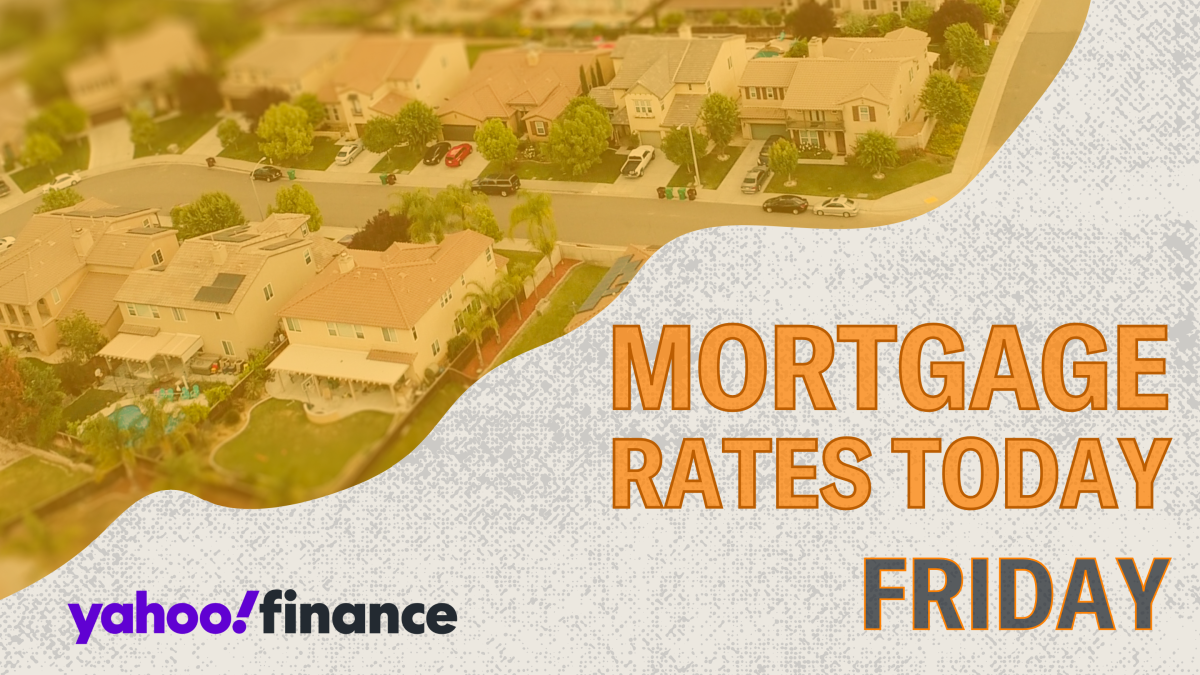Mortgage rates increased again this week. According to Freddie Mac, the average 30-year fixed rate is 7.04%, surpassing the 7% mark for the first time since May.
However, you probably shouldn’t be too put off by this week’s Freddie Mac rate data. Freddie Mac’s published rates are based on mortgage interest rates issued in the previous week. Positive inflation data recently came out that could push rates a bit lower. So, if you’re otherwise financially ready to buy a house, now could be a good time to start shopping for homes and lenders.
Dig deeper: The best mortgage lenders for first-time home buyers
Have questions about buying, owning, or selling a house? Submit your question to Yahoo’s panel of Realtors using this Google form.
Here are the current mortgage rates, according to the latest Zillow data:
-
30-year fixed: 6.72%
-
20-year fixed: 6.45%
-
15-year fixed: 5.99%
-
5/1 ARM: 6.97%
-
7/1 ARM: 6.87%
-
30-year VA: 6.17%
-
15-year VA: 5.62%
-
5/1 VA: 6.21%
-
30-year FHA: 6.33%
-
5/1 FHA: 6.38%
Remember, these are the national averages and rounded to the nearest hundredth.
Learn more: 5 strategies to get the lowest mortgage rates
These are today’s mortgage refinance rates, according to the latest Zillow data:
-
30-year fixed: 6.74%
-
20-year fixed: 6.55%
-
15-year fixed: 5.98%
-
5/1 ARM: 7.30%
-
7/1 ARM: 7.27%
-
30-year VA: 6.13%
-
15-year VA: 5.71%
-
5/1 VA: 6.13%
-
5/1 FHA: 6.50%
Again, the numbers provided are national averages rounded to the nearest hundredth. Mortgage refinance rates are often higher than rates when you buy a house, although that’s not always the case.
Learn more: Want to refinance your mortgage? Here are 7 home refinance options.
Yahoo Finance has a free mortgage payment calculator. Use the calculator to see how various mortgage rates and loan terms could affect your monthly payments.
Our calculator also considers homeowners insurance, property taxes, and other expenses that affect your monthly payment. This will give you a better idea of what you’d realistically pay in a month than if you just look at the mortgage principal and interest.
A mortgage interest rate is a fee for borrowing money from your lender, expressed as a percentage. You can choose from two types of rates: fixed or adjustable.
A fixed-rate mortgage locks in your rate for the entire life of your loan. For example, if you get a 30-year mortgage with a 6% interest rate, your rate will stay at 6% for the entire 30 years unless you refinance or sell.
An adjustable-rate mortgage locks in your rate for a predetermined amount of time and then changes it periodically. Let’s say you get a 7/1 ARM with an introductory rate of 6%. Your rate would be 6% for the first seven years, then the rate would increase or decrease once per year for the last 23 years of your term. Whether your rate goes up or down depends on several factors, such as the economy and housing market.
At the beginning of your mortgage term, most of your monthly payment goes toward interest. Your monthly payment toward mortgage principal and interest stays the same throughout the years — however, less and less of your payment goes toward interest, and more goes toward the mortgage principal or the amount you originally borrowed.
Learn more: Adjustable-rate vs. fixed-rate mortgages
A 30-year fixed-rate mortgage is a good choice if you want a lower mortgage payment and the predictability that comes with having a fixed rate. Just know that your rate will be higher than if you choose a shorter term and will result in paying significantly more in interest over the years.
You might like a 15-year fixed-rate mortgage if you want to pay off your home loan quickly and save money on interest. These shorter terms come with lower interest rates, and since you’re cutting your repayment time in half, you’ll save a lot in interest in the long run. But you’ll need to be sure you can comfortably afford the higher monthly payments that come with 15-year terms.
Read more: How to decide between a 15-year and 30-year fixed-rate mortgage
Typically, an adjustable-rate mortgage could be good if you plan to sell before the introductory rate period ends. Adjustable rates usually start lower than fixed rates, then your rate will change after a predetermined amount of time. However, 5/1 and 7/1 ARM rates are very similar to 30-year fixed rates right now. Before getting an ARM just for a lower rate, compare your rate options from term to term and lender to lender.
Mortgage rates started dropping in August and the beginning of September — but as of mid-September, they’ve been holding stagnant or increasing for the most part.
In fact, they’ve gone up for several straight weeks.
Mortgage rates will probably decrease throughout 2025, but it’s unclear how drastically they will fall due to the uncertainty of how Trump’s presidency will impact inflation and other aspects of the economy. We can expect to see rates stay above 6%.
Read more: When will the housing market crash again?
According to Freddie Mac, this week’s national average 30-year mortgage rate is up 11 basis points to 7.04%, and the average 15-year mortgage rate has increased by 13 basis points to 6.27%.
According to its December housing forecast, Fannie Mae expects the 30-year mortgage rate to end 2025 at 6.20%. The Mortgage Bankers Association (MBA) December forecast is less optimistic, putting the 30-year rate at 6.40% in Q4 2025.
There’s a decent chance mortgage rates will decrease overall in 2025, not increase. However, we will have to see how the next few months shake out as the markets react to Trump’s upcoming presidential term and when the Fed decides to cut its rate.
EMEA Tribune is not involved in this news article, it is taken from our partners and or from the News Agencies. Copyright and Credit go to the News Agencies, email news@emeatribune.com Follow our WhatsApp verified Channel




